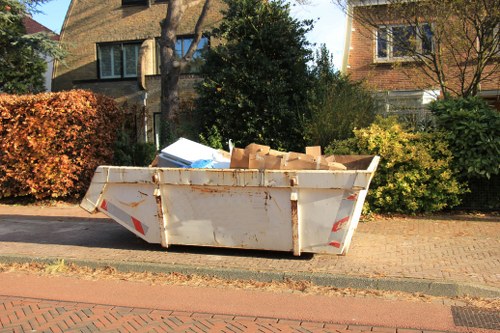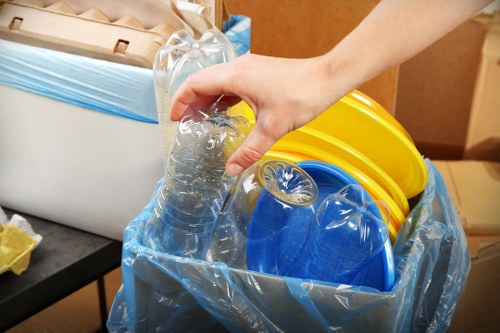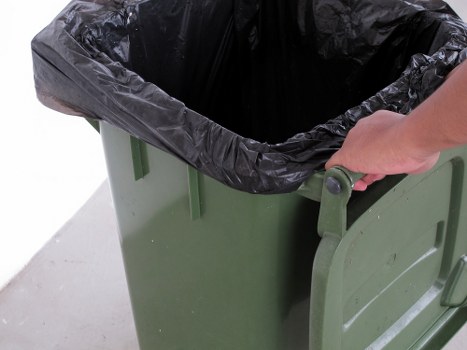Efficient Large Item Collection in Commercial Waste Disposal
Understanding Large Item Collection in Commercial Waste Disposal

In the realm of commercial waste disposal, efficiently managing large items is a critical aspect that businesses must address. Proper waste management not only ensures compliance with environmental regulations but also promotes sustainability and operational efficiency within the workplace.
Large item collection can be a daunting task for many organizations, especially those dealing with bulky materials such as office furniture, electronic equipment, and other substantial waste products. This article delves into the best practices and strategies for effective large item collection in commercial settings.
Understanding the intricacies of commercial waste disposal is essential for businesses aiming to minimize their environmental footprint while maintaining a clean and organized workspace. By implementing the right waste management solutions, companies can enhance their reputation, reduce costs, and contribute positively to the community.
The Importance of Large Item Collection

Effective large item collection plays a pivotal role in maintaining a sustainable business environment. It ensures that bulky waste is removed promptly, preventing clutter and potential hazards in the workplace.
Moreover, responsible disposal of large items helps in recycling materials, reducing the strain on landfills, and conserving natural resources. Businesses that prioritize sustainable waste management practices often enjoy enhanced brand reputation and customer trust.
Furthermore, adhering to environmental regulations through proper waste disposal mitigates the risk of legal penalties and fosters a culture of responsibility within the organization.
Challenges in Large Item Collection

Managing large item collection in a commercial setting comes with its set of challenges. These include:
- Space Constraints: Limited storage areas can make the accumulation of bulky waste problematic.
- Heavy Lifting: Moving large items requires specialized equipment and trained personnel to prevent injuries.
- Regulatory Compliance: Navigating the complex landscape of waste disposal regulations can be overwhelming.
- Cost Management: Large item disposal can be more expensive compared to standard waste collection services.
Addressing these challenges requires a strategic approach that involves planning, investment in the right tools, and partnering with reliable waste disposal services.
By anticipating potential obstacles, businesses can implement solutions that streamline the large item collection process and enhance overall efficiency.
Best Practices for Large Item Collection

1. Develop a Comprehensive Waste Management Plan
A well-structured waste management plan outlines the procedures for collecting, handling, and disposing of large items. This plan should include:
- Identification of Waste Types: Categorize the large items to determine the appropriate disposal method.
- Scheduling: Establish regular collection times to prevent waste buildup.
- Roles and Responsibilities: Assign tasks to team members to ensure accountability.
Having a clear plan helps in coordinating efforts and maintaining consistency in waste management practices.
2. Invest in Proper Equipment
Handling large items requires specialized equipment such as forklifts, pallet jacks, and dollies. Investing in the right tools ensures that waste collection is carried out safely and efficiently.
Additionally, providing necessary training to staff on how to use this equipment can prevent accidents and enhance productivity.
3. Partner with Professional Waste Disposal Services
Collaborating with experienced waste disposal companies can significantly streamline the large item collection process. These professionals offer:
- Expertise in handling various types of large waste items.
- Compliance with environmental regulations.
- Timely and reliable waste removal services.
Partnering with experts allows businesses to focus on their core operations while ensuring their waste disposal needs are met effectively.
Environmental Impact of Large Item Disposal

The disposal of large items has substantial environmental implications. Improper disposal can lead to increased landfill use, pollution, and waste of recyclable materials.
- Landfill Overuse: Large items take up significant space in landfills, accelerating the depletion of available land.
- Pollution: Certain materials, such as electronics, can release harmful substances if not disposed of correctly.
- Resource Wastage: Many large items contain recyclable components that can be repurposed, reducing the need for new raw materials.
By adopting sustainable disposal practices, businesses can minimize their environmental footprint and contribute to the preservation of natural resources.
Recycling and reusing materials from large items not only benefits the environment but can also lead to cost savings and operational efficiencies.
Compliance with Waste Disposal Regulations
Adhering to local and national waste disposal regulations is imperative for businesses engaged in large item collection. Non-compliance can result in hefty fines, legal actions, and damage to the company's reputation.
- Understanding Regulations: Stay informed about the latest waste management laws and guidelines relevant to your industry and location.
- Proper Documentation: Maintain accurate records of waste disposal activities, including types and quantities of items disposed of.
- Training Employees: Ensure that all staff members are aware of regulatory requirements and follow best practices in waste handling.
Implementing robust compliance strategies safeguards the business against potential legal issues and fosters a culture of responsibility.
Regular audits and reviews of waste management practices can help identify areas for improvement and ensure ongoing adherence to regulations.
Cost-Effective Strategies for Large Item Collection
Managing the costs associated with large item collection is a significant concern for many businesses. Implementing cost-effective strategies can help reduce expenses without compromising on quality.
1. Optimize Collection Schedules
By strategically scheduling waste collection, businesses can minimize the frequency of pickups, thereby reducing costs. Analyzing waste generation patterns can aid in determining the most efficient collection times.
2. Implement Recycling Programs
Recycling large items not only benefits the environment but can also lead to financial savings. Many materials can be resold or reused, offsetting disposal costs.
3. Negotiate with Waste Disposal Providers
Engaging in negotiations with waste disposal companies can result in better pricing and customized service packages that align with the business's specific needs.
- Bulk Discounts: Availing services for multiple large items at once can often secure discounts.
- Customized Plans: Tailoring waste management plans to fit the business's requirements can prevent unnecessary expenses.
By adopting these strategies, businesses can achieve a balance between effective waste management and budgetary constraints.
Moreover, regularly reviewing and adjusting waste management practices ensures ongoing cost efficiency and adaptability to changing business needs.
Technology and Innovation in Large Item Collection
Advancements in technology are revolutionizing the way businesses handle large item collection in commercial waste disposal. Leveraging innovative solutions can enhance efficiency and reduce operational complexities.
1. Automated Waste Management Systems
Automated systems streamline the waste collection process by tracking waste generation, scheduling pickups, and optimizing routes for waste disposal vehicles.
- Real-Time Monitoring: Provides up-to-date information on waste levels and collection status.
- Data Analytics: Helps in making informed decisions based on waste patterns and trends.
Implementing such systems can lead to improved accuracy and reduced manual intervention in the waste management process.
2. Sustainable Disposal Technologies
Innovative technologies focused on sustainability, such as waste-to-energy conversion and advanced recycling techniques, offer environmentally friendly alternatives for large item disposal.
These technologies not only reduce the environmental impact but also create opportunities for energy generation and material recovery.
3. Mobile Applications for Waste Management
Mobile apps facilitate seamless communication between businesses and waste disposal services. Features may include scheduling, tracking, and reporting, enhancing overall coordination.
- Ease of Use: Simplifies the process of booking and managing waste collection services.
- Transparency: Provides visibility into waste handling processes and service performance.
Adopting such technological solutions can lead to more efficient and transparent waste management practices.
Training and Safety in Large Item Collection
Ensuring the safety of employees involved in large item collection is paramount. Proper training and adherence to safety protocols can prevent accidents and promote a safe working environment.
1. Comprehensive Training Programs
Developing training programs that cover the correct handling of large items, usage of equipment, and emergency procedures is essential for employee safety.
- Hands-On Training: Provides practical experience in handling and moving large waste items safely.
- Safety Workshops: Educates employees on potential hazards and preventive measures.
Regular training sessions ensure that employees remain knowledgeable and vigilant about safety practices.
2. Personal Protective Equipment (PPE)
Providing appropriate PPE, such as gloves, helmets, and safety boots, is crucial in protecting employees from potential injuries during waste collection tasks.
Ensuring that PPE is readily available and properly maintained contributes to a safer workplace.
3. Implementing Safety Protocols
Establishing clear safety protocols, including proper lifting techniques and equipment handling procedures, reduces the risk of accidents and enhances operational safety.
- Standard Operating Procedures (SOPs): Clearly defined procedures for waste collection activities.
- Regular Safety Audits: Assessing and improving safety measures to align with best practices.
Adhering to these protocols fosters a culture of safety and responsibility among employees.
Case Studies: Successful Large Item Collection in Commercial Settings
Examining real-world examples can provide valuable insights into effective large item collection strategies. Below are case studies highlighting successful implementations:
Case Study 1: TechCorp Offices
TechCorp, a leading technology company, faced challenges with disposing of outdated electronic equipment and office furniture. By partnering with a professional waste disposal service, they implemented a structured collection schedule and engaged in extensive recycling efforts.
- Outcome: Reduced landfill contributions by 40% and achieved compliance with electronic waste regulations.
- Benefits: Enhanced company reputation and cost savings through material recycling.
Case Study 2: GreenBuild Construction
GreenBuild, a construction firm, needed to manage large volumes of construction debris efficiently. They adopted sustainable disposal technologies and invested in automated waste tracking systems.
- Outcome: Increased operational efficiency and minimized environmental impact.
- Benefits: Streamlined waste management processes and improved project timelines.
These case studies demonstrate the importance of strategic planning and the adoption of best practices in large item collection and commercial waste disposal.
By learning from these examples, other businesses can implement similar strategies to achieve effective waste management outcomes.
Future Trends in Large Item Collection
The landscape of commercial waste disposal is continually evolving, with emerging trends shaping the future of large item collection. Staying abreast of these trends can help businesses adapt and optimize their waste management practices.
1. Circular Economy Practices
The circular economy model emphasizes the reuse, refurbishment, and recycling of materials, reducing the need for new resources. Businesses are increasingly adopting circular practices in their waste management strategies.
- Material Recovery: Extracting valuable materials from large items for reuse in new products.
- Product Lifecycle Extension: Extending the usability of products through maintenance and refurbishment.
Embracing circular economy principles can lead to sustainable growth and resource conservation.
2. Smart Waste Management Systems
Integration of Internet of Things (IoT) devices in waste management allows for real-time monitoring and data-driven decision-making. Smart sensors can track waste levels, optimize collection routes, and predict future waste generation.
This technological integration enhances efficiency, reduces operational costs, and improves service quality.
3. Increased Focus on Sustainability
There is a growing emphasis on sustainable waste management practices, driven by environmental concerns and consumer demand for responsible business operations. Companies are seeking eco-friendly disposal methods and aiming to achieve sustainability certifications.
- Eco-Friendly Disposal: Prioritizing methods that minimize environmental impact.
- Sustainability Certifications: Attaining certifications like ISO 14001 to demonstrate commitment to environmental management.
Focusing on sustainability not only benefits the environment but also enhances corporate reputation and stakeholder trust.
Conclusion
Effective large item collection in commercial waste disposal is integral to maintaining a sustainable and efficient business operation. By understanding the challenges, implementing best practices, and leveraging technology, businesses can manage their bulky waste responsibly.
Prioritizing proper waste management not only ensures compliance with environmental regulations but also fosters a culture of sustainability and responsibility. Investing in the right equipment, training, and partnerships with professional waste disposal services can lead to significant operational improvements and cost savings.
As the waste management landscape continues to evolve, staying informed about emerging trends and adopting innovative solutions will be crucial for businesses aiming to enhance their waste disposal strategies.
Contact us today to learn more about how our commercial waste disposal services can help your business manage large items efficiently and sustainably. Book your service now and take a proactive step towards a greener and more organized workplace.